MESA (Microsurgical Epididymal Sperm Aspiration) is a surgical sperm extraction approach done in males with vasal or epididymal obstructions, to retrieve sperm-containing fluid from epididymis. This procedure, used with ICSI (Intra-Cytoplasmic Sperm Shot), has proved to be of tremendous advantage in cases of obstructive azoospermia, where sperms are produced in satisfactory figures but are obstructed from touring from the testicle to the ejaculate. This process is also done when the vas deferens is blocked, severed or missing.
The procedure is carried out inside an operating room. It uses an operating microscope to discover the tubules from the epididymis in a proper way in order to extract a large number of sperm. It is done under general, spinal or local anesthesia. The medical doctor uses a cannula to extract the motile sperms from the epididymides.
An incision is done inside the scrotal skin to expose the testis and epididymis. Utilizing higher-strength visual magnification offered by a working microscope, the epididymal tubules are recognized and opened up and then sperms are extracted.
The sperms gathered from epididymis are usually considered to be of better quality compared to those collected right from the testicles simply because they have got additional time to mature. The gathered sperm can be used immediately or kept frozen to be used later. If no sperm are found, then it is necessary to go for following treatment known as TESE or testicular sperm extraction to look within the testicle for viable sperm.
Sperms retrieved through MESA are well prepared immediately and evaluated inside the laboratory. When the sperm are found post examination, it is initially frozen in liquid nitrogen (cryopreservation). The quantity of sperm accumulated through MESA is usually reduced and not able to carry out self-fertilization. Hence, the partner’s eggs are always fertilized using ICSI. Without ICSI, IVF entails combining thousands of motile sperms with each egg within a dish. It is anticipated that sperms and eggs would interact through biochemistry but in cases where either egg or sperm elements are deficient, then very few of the eggs get fertilized after overnight incubation with sperms.
Every married couple begins a new journey with hopes of a happy home “complete” with a family, the plan of which begins with ‘when’, later turning out as ‘whether it will ever be!’
We hear a myriad number of stories where women get pregnant with one-night stands and get abortions done or end up with accidental or unwanted pregnancies and get abortions or still continue, but then those who are craving for at least one baby are left with a feeling that only their life is unfair to them.
Infertility, since time immemorial, has been considered a bane with a greater plight of accusations towards the feminine sex.
Constant thoughts of pregnancy and seeing everyone around getting pregnant brings in a ray of hope; but when the ‘road to getting pregnant’ gets bumpy, a feeling of despair, hopelessness and even of worthlessness with own body sets in. Further disappointment comes in on seeing friends’ posts or pictures of their newborn babies or of a happy ‘complete’ family on social media. The ‘sufferers’ wish people would understand the feelings they experience. Talking to family, or close friends definitely helps, and those deprived of trusted people face societal pressure, hence avoid social occasions as mere citing a pregnant woman or a baby could invite depression. Getting pregnant becomes desperation because ‘society doesn’t let them live’. Men tend to hide their problems and emotions. There would be on and off feelings of denial, despair, fear, anxiety, depression, anger, guilt, and social ostracism. Further grief adds up when a marital relationship becomes rocky. Infertility, thus, is a sensitive issue.
This is where the role of doctors becomes pivotal. They need to be empathetic and compassionate and understand that patients undergo treatment with tears in eyes and an unwavering hope that everything would turn out good; sometimes even feeling self-doubt whether the treatment would ever be fruitful. One positive word from the doctor could incite in the couple a strong ray of hope out of treatment. This motivates them to proceed with the treatment; although a small seat in their minds would still be occupied by fear. They crave a cent percent-guaranteed-treatment that can make them parents but sadly, no such treatment exists. ART (Artificial Reproductive Technique) hence proves more beneficial compared to conventional and non-ART options.
IVF (In Vitro Fertilization) is a technique where a female gamete is fertilized with the male gamete outside the body. This technique has proven to be a boon in the lives of infertile couples. Initially introduced in a case of blocked fallopian tubes, IVF now is widely applicable in a variety of causes of infertility.
It’s not uncommon to see a female partner come alone or accompanied by one of her family members for the first visit. Same way, a male partner coming alone to share his report of poor semen quality or even of azoospermia hoping for improvement without revealing anything to the partner has also been seen. Counseling plays a major role in such cases. The doctor has to counsel them that infertility is not something to be ashamed of. It’s not a blame-game either. It may not always be curable but it’s treatable in most cases. Counseling the partners that the cause could center around from male- to female- partner, to both, or to even none, and making them realize that understanding and supporting each other could bring about a great deal of strength in progressing with the treatment, helps.
It thus becomes important to investigate both the partners. An IVF centre worth its salt emphasizes on only necessary and important tests so that IVF doesn’t become a costly affair; concentrates on a patient- and cost-friendly approach and believes that already a psychological and emotional investment, IVF shouldn’t turn out into a financial one.
Necessary tests are those that point to the cause of infertility as well as help plan the best treatment keeping the chances of success in mind. These include testing for ovarian reserve by blood tests and ultrasound scan, uterine cavity by ultrasound and/or hysteroscopy, and analyzing semen parameters.
Well, people are widely opinionated about IVF. According to some, IVF is synonymous with conception using donor gametes. Whilst some would accept it immediately courtesy their desperation for a child, there are others who would wonder if their family would agree with this treatment, and still, others who would not want society to know it’s an IVF baby and an added advantage of an IVF centre located far away from their residence or public arena so that nobody sees them visiting the same would always be welcome! Well of course, to each his own and, respecting the couple’s decision on how they would want their privacy kept should always be practiced. There is, of course, no need for the whole world to know nor is it mandatory for them to inform even their own parents or for the doctors to discuss with their parents or family without the couple’s knowledge.
Causes of infertility-
Pelvic pathology (ovarian, tubal, uterine), fibroids, adenomyosis, uterine adhesions, uterine polyps, chronic endometritis, tubal block, ovulatory dysfunction, PCOS, aging women, career-oriented women postponing pregnancy, lifestyle changes (smoking, alcohol, tobacco consumption, lack of exercise and sleep, wrong eating habits), obesity, stress, occupational hazards, environmental pollution, chromosomal abnormalities, unexplained infertility, male problems, genetic defects of one or both partners, unusual problems.
Procedure-
IVF is an ART comprising of controlled ovarian hyperstimulation followed by retrieval of eggs from the ovaries, fertilization with sperms in the laboratory and subsequent transfer of the so-formed embryos inside the uterus. The embryos are cultured in the laboratory till 5 days. The treatment is now highly refined with the application of ICSI (Intra Cytoplasmic Sperm Injection), Blastocyst culture, Laser Assisted Hatching, TESE (testicular sperm extraction) to name a few.
Although the couple is helped to conceive their own biological child in most cases, the use of donor gametes (donor eggs or donor sperms), donor embryos, gestational surrogacy is called for according to the circumstances.
Advantages-
IVF is useful not just in blocked fallopian tubes, but also in women with poor or diminished ovarian reserves, PCOS, POI, endometriosis, uterine fibroids, adenomyosis, abnormal semen parameters, in couples married for long with primary or secondary infertility, unexplained infertility and in couples with failure of non-ART cycles.
Those men with nil sperm count could also attempt testicular biopsy and hope of being blessed with a child with own sperm (if) retrieved from testis!
Young working women busy with their careers is not a rare citing nowadays and they could opt for egg freezing with their biological clock ticking fast without their knowledge.
Cryopreservation of oocytes has also come as a boon for women with cancer.
Surrogacy– indicated- when the woman’s womb created to bear a child ‘refuses’ to do so (uterine adhesions)
– Medical condition of woman does not permit a pregnancy within her uterus, absent uterus (mullerian agenesis, previous hysterectomy).
PGD/PGS – Women with a genetic disorder (PGD), with repeated unexplained IVF failures (PGS).
Myths-
People have misconceptions that IVF (is) –
1. A problem of the female
2. Expensive
3. Unsafe
4. Painful
5. Requires admission in hospital
6. Requires complete bed rest
7. The last option
8. A complicated procedure
9. Carries a low success rate
10. May produce genetically abnormal babies
11. High chances of multiple pregnancies
12. High chances of cesarean births
13. Eggs get depleted after donation
14. IVF babies would need IVF in their future
15. Couples need to just relax and give some time and they will conceive
A misconception, prevailing in an era when IVF was new, that a technique as complicated as IVF could ever maintain genetic integrity.
Studies have not found an increase in birth defects in IVF babies as compared to naturally conceived ones.
Need to be on daycare for egg retrieval.
The age-old belief/myth that bed rest after embryo transfer has been proven not just wrong but also otherwise. The myth has taken so much of prevalence that patients even enquire during their very first visit to a fertility clinic about any need whatsoever of complete bed rest during IVF and after embryo transfer.
IVF is the most efficient technology to deal with infertility with a high success rate. Since its invention in 1978, more than 50 Lac babies have been born by this technology worldwide till date!
Various reports suggest that the number of IVF cycles is on the rise, and with the same rate, it is estimated to triple by the year 2020. According to the EY report, more than 15% of married couples in India seek IVF treatment and about 22 to 33 million couples in the reproductive age group suffer from lifetime infertility. At such pace, by 2020, the number of infertile couples could increase to 244 million.
Any health habit or stress proven unfavorable for IVF success should be discouraged.
But every hour of the day and every ounce of importance need not be given to every “must-do” that a sense of guilt builds in if not done.
People need to realize that IVF is not a fail-safe solution but is undoubtedly a light at the end of the tunnel!
Knowledge of infertility and the need for timely treatment require to be reached to remote places.
Let’s remove the social stigma and ostracism still prevailing in Indian society.
At Indira IVF and fertility center, our fertility experts are keen to help and resolve all your queries related to infertility or IVF. You can book your appointment for a free consultation now.
Articles
2022


Guide to infertility treatments ICSI
Advantage and Disadvantage of ICSI
Pros and Cons of ICSI ICSI or Intracytoplasmic Sperm Injection is a form of...
2023


Guide to infertility treatments ICSI
What is Azoospermia? Azoospermia is a condition in which a man has no measu...
2022


Guide to infertility treatments ICSI
In this world full of health concerns and complicated terminologies that tag a...
Pregnancy Calculator Tools for Confident and Stress-Free Pregnancy Planning
Get quick understanding of your fertility cycle and accordingly make a schedule to track it















